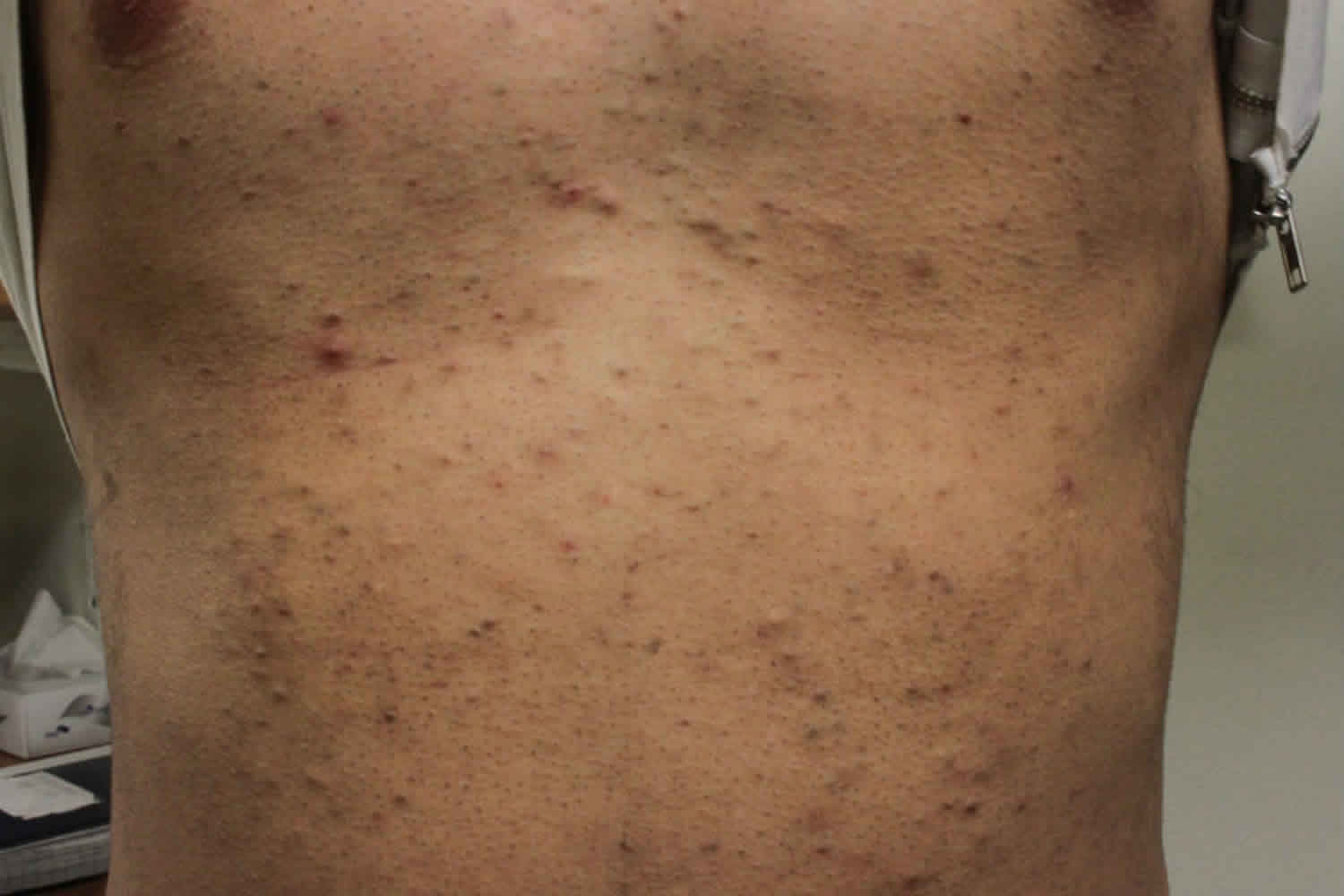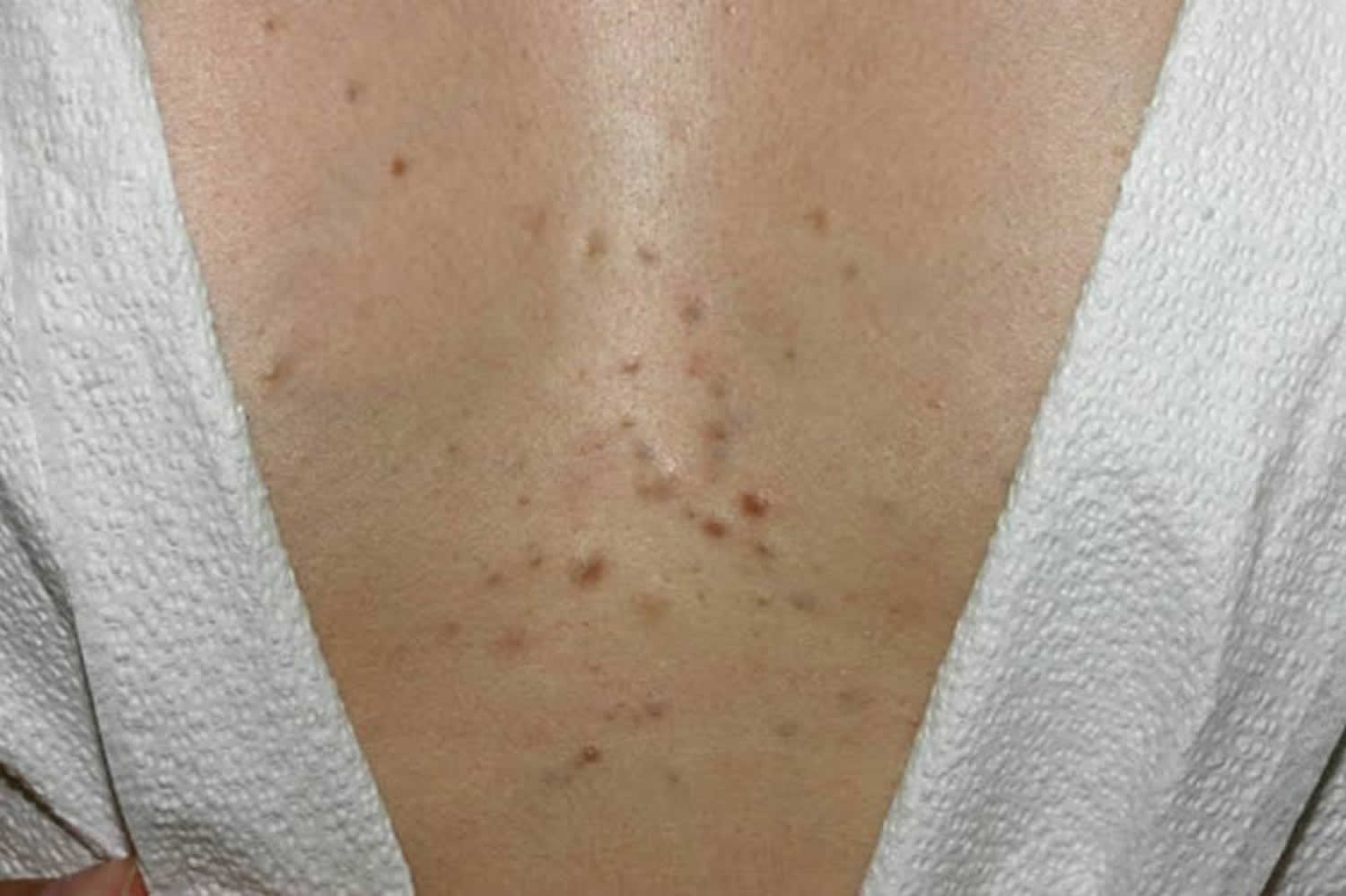Eruptive vellus hair cyst
Eruptive vellus hair cyst is small papule containing vellus hairs, which is a rare follicular developmental abnormality of the vellus hair follicles 1. Eruptive vellus hair cysts are usually seen in children, adolescents, or young adults and manifest as reddish-brown smooth papules most commonly involving the central chest, limbs, and abdomen.
Eruptive vellus hair cysts cause is still unknown. They could be sporadic or autosomal dominant and manifest as reddish-brown smooth papules of 1–4 mm diameter usually involving the chest, limbs, and abdomen. Eruptive vellus hair cysts are likely to be familial when they occur in early childhood. Sporadic forms tend to develop later in teenage years. Boys and girls are equally affected.
Eruptive vellus hair cysts are usually an isolated finding and not associated with other skin abnormalities. Eruptive vellus hair cysts sometimes arise in children with anhidrotic and hidrotic ectodermal dysplasia, steatocystoma multiplex or pachyonychia congenita 2.
They are uncommon benign tumors of pilosebaceous unit, and in about 25% of cases, spontaneous resolution occurs 3. Histologically, eruptive vellus hair cyst is characterized by cystic spaces lined by stratified squamous epithelium composed of variable amounts of laminated keratin and multiple transversely and obliquely cut vellus hair 4. The cyst wall may be in continuity with an atrophied hair follicle or arrector pili muscle. Usually, no sebaceous glands are present within the cyst wall. The cyst may be surrounded by a granulomatous inflammation 5, leading to partial destruction of the cyst wall. Eruptive vellus hair cysts have a predilection for middle or upper dermis. Histopathological diagnosis can be a challenge due to their relative rarity and because they are often clinically misdiagnosed.
Currently, there is no standard treatment for eruptive vellus hair cysts. Improvement with dermabrasion, erbium:YAG or carbon dioxide laser vaporization, and needle incision have been cited in the literature, but a large number hinders complete resolution. Although benign, eruptive vellus hair cysts is difficult to treat with no response to oral isotretinoin 6.
Figure 1. Eruptive vellus hair cysts
What is vellus hair?
Vellus hairs are fine, blond hairs normally growing on the face, trunk and limbs. In contrast, terminal hairs are longer, pigmented hair and mainly arising on the scalp, beard, underarms and pubic area.
Eruptive vellus hair cysts causes
Eruptive vellus hair cysts are thought to be the result of occlusion (blockage) at the level of the infundibulum (the part of the hair follicle just below the epidermis), subsequent cystic dilatation (enlargement) of the hair follicle and secondary atrophy (withering) of the hair bulb. This is probably a developmental abnormality.
Keratin gene mutations are a likely association in familial cases when they have an autosomal dominant inheritance. This means an abnormal gene comes from one parent. In some cases, mutations have occurred in the gene that encodes keratin 17 (K17).
Eruptive vellus hair cysts symptoms
Eruptive vellus hair cysts usually presents as small, red-brown or blue-grey papules, most commonly on the central chest, although other sites can be affected, and occasionally it can be generalized. They have also been reported to occur on the limbs. There may be few to numerous cysts, sometimes numbering in the hundreds.
Individual lesions are usually small smooth dome-shaped papules, 2–3 mm in size. They may be dimpled or umbilicated and sometimes have a scaly or crusty surface.
Eruptive vellus hair cysts diagnosis
The diagnosis of eruptive vellus hair cysts is often made clinically, because of the typical age of onset, the site of the lesions, and their appearance.
Incision or puncture of the cyst and examination of the contents under a microscope will reveal the vellus hairs.
A skin biopsy may confirm the diagnosis. Histopathology shows stratified-squamous epithelium with a granular layer that surrounds a cystic space filled with laminated keratin and a variable number of vellus hair shafts.
Eruptive vellus hair cysts treatment
In many cases, treatment is unnecessary as eruptive vellus hair cysts are harmless. The cysts disappear by themselves in about 25% of children.
Long term use of keratolytic creams containing urea or salicylic acid may be useful. The use of topical retinoids (tretinoin 0.05% cream daily or tazarotene 0.1% cream daily) or keratoytics (12% lactic acid lotion or 10 – 20% urea cream), may provide some benefit and are unlikely to cause harm. Eruptive vellus hair cysts have no response to oral isotretinoin 6.
Individual lesions may be removed surgically by excision, curettage, cryotherapy or laser ablation with CO2 and erbium:YAG has been used, but this is likely to result in scarring. The remission is short as relapse is almost always the end result.
References- Anand P, Sarin N, Misri R, Khurana VK. Eruptive Vellus Hair Cyst: An Uncommon and Underdiagnosed Entity. Int J Trichology. 2018;10(1):31–33. doi:10.4103/ijt.ijt_61_17 https://www.ncbi.nlm.nih.gov/pmc/articles/PMC5803851
- Eruptive vellus hair cysts. https://dermnetnz.org/topics/eruptive-vellus-hair-cysts/
- Sina B, Burnett JW. Eruptive vellus hair cysts. Cutis. 1984;33:503–4.
- Rao R, Balachandran C. Asymptomatic papular lesions on the trunk. Indian J Dermatol Venereol Leprol. 2009;75:217–9.
- Haritha K, Parthasaradhi A, Jalu J. Eruptive vellus hair cyst. Indian J Paediatr Dermatol. 2016;17:76–8.
- Karadag AS, Cakir E, Pelitli A. Eruptive vellus hair cysts: An alternative diagnosing method. Indian J Dermatol Venereol Leprol. 2009;75:537–8.






